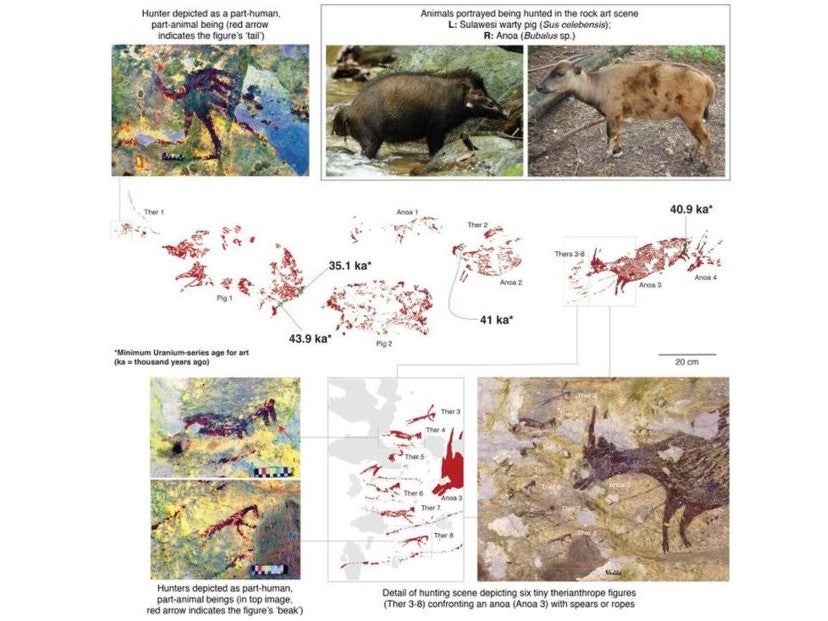Scientists in Indonesia say they have discovered the oldest ever cave painting depicting a story, estimated to be some 44,000 years old.
The red images daubed onto a cave on the island of Sulawesi show small human-like figures who appear to be hunting wild animals.
The findings have been published in a study in the journal Nature, which details how a mostly-Australian team of scientists uncovered the Sulawesi paintings in a cave called Leang Bulu’ Sipong 4 in the south of the island.
Although the cave art is not the oldest ever drawing found, if the researcher’s interpretation of the scene is correct it is by far the oldest painting which shows some kind of narrative.
The oldest ever drawing was found on a rock in South Africa last year and is thought to be 73,000 years old.
The study’s authors believe the images in Indonesia show a group of supernatural human figures – people with some animal traits such as tails or bird heads – hunting a type of local buffalo and wild pigs with spears or ropes.
“I’ve never seen anything like this before,” said Adam Brumm, an archaeologist from Griffith University in Brisbane, Australia, who was part of the team. “I mean, we’ve seen hundreds of rock art sites in this region – but we’ve never seen anything like a hunting scene.”
Dr Brumm said he screamed with excitement when first shown blurry photos of the paintings by a colleague.
Although the caves they were found in have been studied for their artwork for decades, this particular set of images escaped notice until recently because they are high off the ground. They were only discovered after an archaeologist climbed up a fig tree.
“If the dates from the article are correct, the images would be some of the earliest figurative images known anywhere, and of great importance,” commented Nicholas Conard, an archaeologist at the University of Tübingen in Germany who was not involved with the research.
Maxime Aubert, another Griffith University archaeologist, said it was still unclear exactly what kind of story the paintings showed but it was important evidence on the development of early human understanding and creativity.

“It’s quite amazing. It’s a narrative scene, and it’s the first time we see that in the rock art,” he said.
“The humans there, they are not fully human: One has a tail, then others may have some sort of bird head or something. I think it’s probably something that didn’t really exist. Maybe it’s part of a mythical creature… We don’t know. But it is one of the possibilities.”
“The images of therianthropes [animal-human figures] at Leang Bulu’ Sipong 4 may also represent the earliest evidence for our capacity to conceive of things that do not exist in the natural world, a basic concept that underpins modern religion,” Professor Brumm said.
But not all archaeologists share their excitement. Paul Pettitt, from Durham University, said he was doubtful if their interpretation was correct.
“Is it a scene? The ‘humanoids’ are depicted horizontally, and at a differing scale to the animals they are said to be hunting.
“As for ‘spears,’ just look at them. They are long lines that just pass close to some humans. Hardly weapons held in the hand.”
He added it was possible the paintings were added to over time, as has been known to have happened in several European caves, rather than daubed on as a single scene.
Either way, the window for further study of the images is small. The study’s authors said they feared the paintings could soon be lost be deterioration in the cave’s wall.
“The surface of the cave is exfoliating like it’s peeling off. And big chunks, every year, are disappearing, and we don’t know exactly why,” Professor Aubert said.

Join our commenting forum
Join thought-provoking conversations, follow other Independent readers and see their replies
Comments